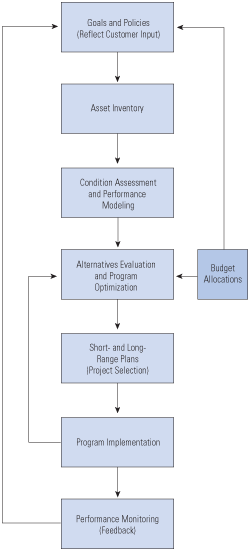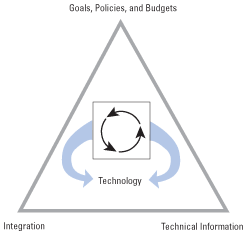Asset Management Overview
Strategies for Implementation
AASHTO and FHWA have made Transportation Asset Management a national priority. They are providing national leadership and guidance to States as they work to incorporate asset management principles and practices into their business processes. The goal of AASHTO and FHWA is to supply generic asset management approaches to organizational integration, performance measure development, application of analytical tools, and information management. These generic processes and tools may then be utilized "as is," or they may be applied after in-house or other customized revisions.
Although the fundamental tenets of asset management are visible in each State practicing the discipline, the assumptions made, tools employed, and information used vary from State to State. Each State brings its unique organizational strengths and perspective to implementation. In addition, each State's Transportation Asset Management program reflects the State's unique decisionmaking process and individual goals. One size will never "fit all" in State asset management.
While there is no standard approach or strategy to implementing asset management, a variety of models, methodologies, tools, and techniques are available to assist in the efficient use of existing resources.4 Agencies must examine exactly where they are, what information they have available, and where they want to go before determining (or continuing) an approach to implementing asset management. Moreover, an agency should remember these important facts:
- Asset management implementation can be accomplished in stages.
- Tasks can be identified as short-term, mid-term, or long-term, and the appropriate sequence and priority of tasks can be defined broadly in the implementation strategy.
- Work can begin in one program area or type of investment (e.g., preservation or maintenance) to demonstrate principles and techniques and to establish the organizational linkages and business process interactions needed to make the approach work. This demonstration can serve as a model for subsequent implementation in other program areas.
- Asset management implies change, and change in an organization can be difficult to deal with.
- Be aware that organizational and institutional changes in asset management will likely present greater challenges than changes in technical or analytic capabilities.
- Discuss strategies that can be put in place to bring about change more effectively, establishing support and confidence among managers and staff.
- Provide for open communication among all personnel involved in implementing the asset management program. An asset management program-
- Can improve understanding by taking some of the mystery out of how and why decisions are made.
- Can improve confidence in agency performance by clearly reporting achievements-and failures-and progress toward established goals.
- Clearly defines, communicates, and links performance measures to the agency's vision and mission so that they have meaning to its customers.
- Requires a culture change. Senior leadership and management of an agency must be committed to the principles of asset management and to providing the resources to implement it.
Approaches to Implementing an Asset Management Program
Generally, two different approaches are accepted in the industry for the implementation of an asset management program: policy-based or performance-based.
Policy-based asset management programs tend to support a long-term, life-cycle approach to evaluating investment benefits and costs. Policy-based decisions on programs for different assets, modes, or types of investments may be based on historical funding baselines, formula-based splits, or deal-making rather than on current performance objectives or targets. Policy-based asset management programs should define the directions and overall priorities for an agency's infrastructure management. It should relate objectives, performance measures, and performance targets. The asset management framework does not prescribe what priorities should come first-only that individual agencies and their policy-making bodies discuss and analyze policy options and adopt the ones that are thought to be warranted.
On the other hand, performance-based asset management programs support the preservation of existing highway assets through the use of identified measures and targets. They enable decisionmakers to identify the optimum balance between availability and utilization for any asset at any given time, based on the real-time performance measures prioritized to current business strategy. The lack of effective performance measures for maintenance, operation, and engineering, however, has resulted in performance approaches based more on budget cost management than on asset performance management.

Performance-based asset management is a process of managing an infrastructure system in order to optimize its behavior when evaluated against specified objectives. It enables prioritization of investment in highway infrastructure construction, inspection, and maintenance. It is risk based, in that the costs of alternative investments are weighed against their benefits. It also has to take account of the multiple objectives for highway assets, including economic efficiency, the environment, and safety.
The Generic Asset Management System (see Figure 1), which serves as a framework and guide to the asset management process, shows the importance of defining Goals and Policies at the start and using Performance Monitoring as a check. A system can be either policy-driven or performance-driven as long as one is used as a balance for the other. For example, an agency may adjust its policies higher or lower based on the feedback gathered by performance monitoring that is used to check conformance to the policy. When the data come back, an agency may find that it is already doing better than its stated policy objectives or it may find that the policy objectives are not realistic or need to be placed on a longer time track.
FIGURE 1. The components of a generic asset management system, the relationships among them, and key questions that inform the system's analytical process. (from Asset Management Primer, 1999, p. 19)
| System Components | Key Questions |
|---|---|
 |
What is our mission? What are our goals and policies? What is included in our inventory of assets? What is the value of our assets? What are their functions? What services do they provide? What was the past condition and performance of our assets? What is the current and predicted future condition and performance of our assets? How can we preserve, maintain, or improve our assets to ensure the maximum useful life and provide acceptable service to the public? What resources are available? What is the budget level? What is the projected level of future funding? What investment options may be identified within and among asset component classes? What are their associated costs and benefits? Which option, or combination of options, is "optimal"? What are the consequences of not maintaining our assets? How can we communicate the impact of the condition and performance of our assets on the system and end user? How do we monitor the impact of our decisions? How do we adjust our decisionmaking framework when indicated? How can we best manage our assets in order to least inconvenience the motoring public when we repair or replace these facilities? |
Steps to Implementing an Asset Management Program
The steps involved in implementing transportation asset management can be summarized as follows and are discussed below:
- Review the organization's structure.
- Conduct an asset management self-assessment.
- Identify the asset management policies and goals to be achieved.
- Prepare and implement an asset management action plan.
- Review and monitor progress.
- Solicit feedback from stakeholders.
Review the Organization's Structure
A transportation agency can begin to implement asset management principles and practices right away. Most organizations already have resources devoted to asset management but have not taken the opportunity to fully develop these resources into an organized program. It is important to identify how investment decisions are currently being made in the agency and how this method differs from an asset management approach to decisionmaking. The primary needs in getting started are a sincere desire to improve the ways in which the transportation agency conducts its business and a commitment from top management to focus on the implementation goals. Asset management is not a fix for overcoming major problems within the organization, but it can help identify methods and resources to solve some of the problems.
Conduct an Asset Management Self-Assessment
A self-assessment will help to identify specific opportunities for improvement within the transportation organization. It will help to organize thinking, identify an organization's strengths and weaknesses, and lay out an action plan for implementing an asset management program. In addition, a self-assessment will build consensus among top managers regarding the status of asset management within the organization.
The Transportation Asset Management Guide, published by AASHTO,5 contains a recommended self-assessment with step-by-step instructions. This tool will quickly provide an overall picture of where a transportation agency is regarding asset management practice. The self-assessment results will reflect the agency's individual institutional, organizational, financial, and information technology environments.
Identify Asset Management Policies and Goals To Be Achieved
An agency's policies and goals will define its most important priorities (see Figure 2). Asset management is a customer-focused, goal-driven management and decisionmaking process. Organizational goals, policies, and budgets establish a consistent evaluative philosophy. Goals and performance indicators are literally the levers that drive the asset management decision framework, establishing investment levels that reflect service levels, and making resource commitments consistent with the perceived needs of the public. Analysis procedures regarding alternative options are used within this framework.
Decisions regarding program investments are optimized according to goals established by elected officials and policymakers. Performance goals provide a way to convey to the public how transportation agency officials are managing the public's assets. Asset management provides a logical, fact-based approach to dealing with and explaining the impact of the practical realities facing transportation system owners today.
The success of program strategies and practices is measured by changes in performance and remaining service life. Performance criteria and measures also help decisionmakers identify and target critical system requirements.
 |
Organizational policies may be thought of as a broad overlay to the process. Nonengineering, noneconomic factors that reflect an agency's values, perceptions, and predispositions may modify performance-based decisions. For example, established policies, or "rules of thumb," may direct an agency to select an investment alternative based on historic practice or other reasons. Also, management may assign noneconomic resource constraints to some asset components.
The key to establishing performance goals is determining user priorities, values, and standards related to areas such as ride smoothness and overall level of service; travel time; overall system mobility; accessibility to the system; and availability of facilities. Goals may be defined in terms of the percentage of assets that meet specified performance levels, as one example.
Prepare and Implement an Asset Management Action Plan
The next step is to define objectives and formulate tasks to achieve each one. Formulating tasks in an action plan will require a look at the overall agency to understand the connections that may exist among issues raised in each area. This requirement does not imply that the agency should try to address every item at once. Rather, a broad perspective will help in identifying priority actions for improving asset management.
Preparing the plan involves examining the elements in the transportation program and, based on established policies and objectives, deciding which elements should be included in the plan-which assets, types of investments, business functions, and techniques (see the box "Choosing What to Include" for examples).
An important aspect of developing an asset management implementation plan is to define a timeframe for each of the improvement activities or tasks, taking into account several factors:
- The overall priority of each task.
- The logical sequence of the tasks required to achieve an objective.
- An agency's annual cycles for policy and process updates, data collection and analysis, budget and program development, or delivery of projects and services. Asset management initiatives should be scheduled to complement current business cycles.
- The resources available to implement the plan. A mixture of short-, mid-, and long-term initiatives will insure that funds and staff availability are not barriers to successful implementation.
Review and Monitor Progress
Asset management plans provide for periodic review of the agency's progress in meeting the performance values it has targeted for preservation, capital improvement, and maintenance and operations. An asset management system is built upon information, which must be continually renewed. To determine whether the system is performing as projected, data on the condition and performance of assets are captured and analyzed regularly. This information on system performance allows for analysis of investment decisions made and provides a basis for future decisions. Decisions are based on information; consequently the quality of the data that are available affects the entire asset management system.
In addition to informing the next asset management planning cycle, monitoring and periodic reviews can help to identify specific areas that require more immediate adjustment, and to serve the public's accountability requirements. In addition to reporting progress internally, many States report at least annually on their progress to their governors, high-level executives, legislatures, and oversight bodies, as well as the general public. These reports serve to educate the officials and policymakers who establish funding priorities about DOT stewardship. The use of plain language in communications with customers is vital to success. The presentation of information should be tailored to the needs of specific groups.
Solicit Feedback From Stakeholders
System users and other stakeholders should be kept abreast of the performance targets, measures, and results that pertain to their satisfaction with the transportation system and services. Typically, on a highway system, users will be concerned about availability and accessibility, congestion and travel time, safety, ride smoothness, and noise. Only by regularly collecting customer perceptions of asset condition and performance, as well as their expectations, can agencies maintain or increase customer satisfaction. Information may be collected through formal and informal customer surveys, focus groups and panels, and on Web sites.
Communication in Asset Management
Not only is communication essential to successful asset management-asset management processes are themselves important communication tools. Communication is of singular importance in developing and implementing an asset management program, particularly because of the involvement of different disciplines and levels within an organization that typically have different perspectives and ways of talking about the transportation system. For the parties to cooperate with changes, it is vital that they understand them. In its communications and reporting plan, an agency must pay particular attention to-
- Linking performance measures in a clear and direct way to the agency's vision and mission.
- Defining clear and precise performance measures and strategies.
- Clarifying goals and related accomplishments in a concise way.
- Reporting progress made in each of the performance areas.
- Illustrating what has been done to meet goals and what still needs to be done.
An asset management program can improve understanding by taking some of the mystery out of how and why decisions are made-"by making a glass box out of the black box. It does this by clearly articulating goals in terms that are meaningful to stakeholders, by documenting current conditions, and by estimating future conditions based on alternative policy strategies and investment levels."6 Because asset management is a fact-based system, it allows for an objective dialogue among all parties. As a system of communication, the practice of asset management can help agencies to-
- Improve confidence in agency performance by clearly reporting achievements-and failures-and progress toward established goals.
- Provide a first step in helping elected policymakers understand the extent of the responsibilities vested in the transportation agency.
- Tip the political scales in favor of greater transportation investments by communicating a common message regularly, flexibly, and by a range of transportation professionals.
- Express goals and performance in terms that relate to customers' desires and in language that customers understand.
- Help government officials at all levels to understand the condition and needs of the transportation system and the practices used to manage it.
Economic Analysis in Asset Management
Economic analysis can play an important role in a comprehensive transportation asset management program. Using economic analysis, transportation agencies can identify, quantify, and value the economic benefits and costs of transportation projects and programs over a multiyear timeframe. The approach involves careful coordination with transportation planners and engineers, who provide information on the performance characteristics and costs of a proposed project. The project's performance measures are put into dollar terms and then compared to the costs of building and maintaining the project over its entire lifespan. With this "dollars and cents" information, agencies are better able to compare projects to each other (through "tradeoff" analysis), select the best mix of projects for any given budget, target scarce resources to their best uses to maximize benefits to the public, and account for their decisions. Many factors of interest to decisionmakers can be included in the economic analysis process, including the risks of changing construction costs and traffic levels on project outcomes, uncertain monetary values for certain project performance measures, and the effects of the investments on jobs, tourism, business growth, and other social goals.
A critical component of a comprehensive project or program evaluation methodology that considers all key quantitative and qualitative impacts of highway investments, economic analysis can inform many different phases of the transportation decisionmaking process. It can assist engineers in the development of more cost-effective designs once a decision has been made to go forward with a project. In planning, it can be applied to basic cost and performance data to screen a large number of potential project alternatives, assisting in the development of program budgets and areas of program emphasis. Similarly, economic analysis can play a critical role in screening alternatives to accomplish a specific project, providing information for the environmental assessment process.
Risk Assessment and Asset Management
The principles of asset management and risk management enhance each other. It is recommended that risk management be integrated with the asset management process. The outcome of risk management is efficiently focusing resources to manage programs through improved communication. Applying risk management to look at decisions being made about delivery of the programs makes it possible to identify threats and opportunities, assess and prioritize those threats and opportunities, and determine strategies so that decisions can be made on how to deal with future issues affecting the Federal-aid highway program.
Risk is a future event that may or may not occur and would have a direct impact on the program to its benefit or detriment. Risk management is the systematic identification, assessment, planning, and management of threats and opportunities faced by our programs. Steps taken to manage risk include 1) gathering information about future events, threats, and opportunities; 2) identifying what and how those future events trigger the threats and opportunities; 3) assessing the likelihood and impact of risks; 4) prioritizing risks by their expected value and by their relative importance to a program, project, or State; 5) determining appropriate response strategies to risks; 6) carrying out response strategies, monitoring strategies, and reevaluating risks.
Role of Preservation in Asset Management
To meet the growing travel demand and the public's expectations for safety, ride quality, and traffic flow, highway agencies are redefining their objectives to focus on activities and strategies to preserve and maintain existing highway systems, instead of on the typical strategy of fixing the worst first. Focusing on preservation without exceeding budgetary limits requires a change of philosophy from reactive maintenance to preventive maintenance. Increasingly, State DOTs report that the proactive approach of preventive maintenance-known as pavement preservation-cuts the need for costly, time-consuming rehabilitation and reconstruction projects and reduces associated traffic disruptions. As a result, the public is seeing improved mobility, reduced congestion, and safer, smoother, longer lasting pavements-the goals of pavement preservation.
To advance these goals, FHWA is partnering with DOTs, industry organizations, and other stakeholders. Their objective is to spread the word that a variety of innovative techniques and strategies can preserve not only pavements, but also the Nation's investment in the highway infrastructure.
The Concept Behind Pavement Preservation
When the ride quality and structural condition of a pavement are allowed to deteriorate to fair or poor condition, as has often been the case, costly, time-consuming rehabilitation becomes necessary to repair structural damage and restore pavement conditions. This "worst first" maintenance practice came about for many reasons, including the requirements of Federal-aid funding and the need to maximize capital growth. More often now, highway agencies can extend a pavement's service life by applying a series of low-cost preventive maintenance treatments, each of which lasts a few years. This practice translates into a better investment and a better ride quality. The experience with pavement preservation in a number of States demonstrates this success: each dollar spent now on pavement preservation could save up to six dollars in the future.7
Pavement preservation is a concept that has long been employed by highway managers and engineers. The degree to which it is employed has varied considerably among different governmental agencies due to questions about the perceived benefits and costs of a pavement preservation program.8
Pavement preservation strategies are not well-suited for pavements requiring major rehabilitation or reconstruction. Furthermore, implementation varies with pavement conditions and climatic, environmental, and other regional factors, requiring each agency to adapt methods to its own conditions. No treatment can ward off pavement deterioration forever. But the strategies and techniques of pavement preservation can significantly slow the rate of deterioration.


